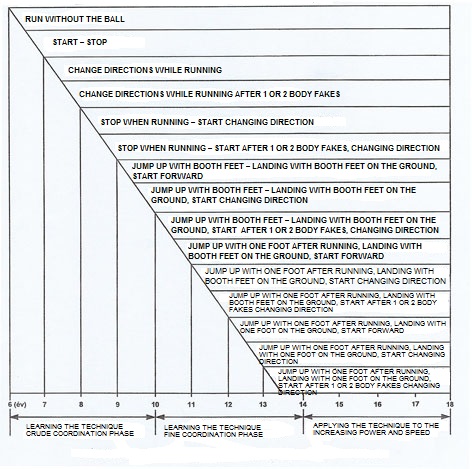The main features of the technical training of football players of various ages
Classification of technical elements:
With the ball: headers, dribbles, faking, shots, passes.
Without the ball: runs, starts, stops, changing directions, jumps, landings, falls, faking without the ball.
The most important element of this training is the running exercises. It is proven by experience that at the age of 10 to 12 years, two sessions per week, about 20 to 30 minutes each, are indispensable. These must include coordination development without the ball, development of the sense of rhythm, hops, start exercises, special football running movements, as well as sprints of 5 to 10 metres. The children should not be required to run for 20 to 30 minutes, or 200, 400 or 600 metres, as these forms of movement are not characteristic of the sport, and therefore may also evoke revulsion.

At the age of 6 to 7 years, the objective is that children get to like football. It is important that every exercise should be done with the ball, with lots of playful tasks; the training elements should be varied and should take a short time. The development of the sense of globe should dominate, and we can also change the size of the ball (size 2 or 3, rubber ball, etc.). There are no fixed positions, everyone should play everywhere. Two training sessions per week, of 60 minutes each, are recommended. At the age of 8 to 9 years, children are already capable of team play, the common teamwork both in attack and defence. The development of the sense of ball and juggling are still important. They already have to know all types of passes on the ground. In addition to the sense of the ball, it is also an important task to get to know and apply the faking exercises. The instruction of taking the ball and to overcome the initial fears is a decisive element at this age. The preparation of headers should take place in lighter conditions (e.g. rubber ball) and should take a short time. We can start to do coordination exercises with the ball, and playing 3-to-1. The basic plays from one-on-one to 4-on-4 are also important in the training. At this age group two or three training sessions a week, of 90 minutes each, are recommended.
The age of 10 to 13 years is particularly important in football training; the objective is the development of the technique and to reach the level of mature playing. By the age of 12 the players have to know almost all technical elements. The training is also complemented by the foundation of the conditional preparation. At this stage, the players are already expected to play in a disciplined manner, in a playing system, and to think in a team. The recommended training time is 90 minutes, three times a week, and an extra session should also be included for talent development. It is important that children should play in more than one position, as they receive more stimuli that way.
In the following, without aiming at completeness, the major technical elements of the age group are described.